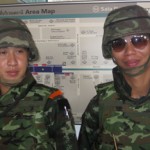One of the most vexing challenges for the Westerner in the East is to understand how decisions are made within the Thai political structure.
The Kingdom of Thailand has been independent since 1238 ACE, and is considered the only country in Southeast Asia never colonized by an imperialist power. It became a constitutional monarchy in 1932. King Bhumibol Adulyadej has ruled since 1946. Although the King has no formal political power as defined by this system, his opinion is revered by individuals, politicians, and the military. In times of national crisis, both the King and Queen Sirikit have provided counsel that has been adhered to by military, legislative, and judicial powers.
Thailand has a lower house (House of Representatives) of 500 individuals elected to four-year terms, responsible for making legislative changes. The upper house (Senate) has 200 members, elected for six-year terms, and is responsible for changes in the constitution. Anyone running for election must have at least a Bachelor’s degree. The Prime Minister is elected to a six-year term. Judges of the Supreme Court are selected by the King. Voting in all elections is compulsory for all citizens of Thailand.
The country is divided into 76 provinces, each of which is led by a Governor, appointed to a four-year term by the Ministry of the Interior. Provinces are divided into Districts, each of which is led by the District Officer (also appointed by the Ministry), who directly reports to the Provincial Governor. Districts are further divided into Sub-districts, Tambon (groups of villages), and Moo Baan (towns). The ‘kamnan,’ who governs a tambon, and ‘puu yai baan’ the headman who controls a village, are elected by popular vote. It has been common practice in elections for kamnan and poo-yai-baan for votes to be paid for, in cash. Government officials at the District level and higher are often referred to in newspapers by the title “Than,” and their wives by “Than Puying.” Retired military personnel serving in civilian government posts are referred to by their titles, such as “Pol Gen” (Police General).
Large municipalities with over 50,000 people are called ‘nakhorn’, whle typically towns with 10,000 to 50,000 people are called ‘muang.’ A provincial capital is called ‘amphur muang,’ commonly abbreviated in addresses as ‘A. Muang.’ Mayors of cities are elected by popular vote. Bangkok is actually considered a province itself, and therefore is run by a Governor, who is elected to a four-year term by popular vote, rather than appointed by the Ministry of the Interior, as are the Provincial Governors.
Pay, Ranking, and Levels of Authority
In the Thai government, the largest political units are the Ministries, divided first into Departments, then Divisions, then Sections. In the civil service, title, pay grades, and responsibility are indicative of a class structure in which one is expected to rise according to a formal schedule. Civil service is divided into five classes, each consisting of three grades. There are four salary steps in each grade, and each civil servant is expected to rise one step within the grade each year.
In the Ministry of Education, for example, the highest class, known as the Special Class, contains most of the top officials. Below that are Division Chiefs in Class One, Section Chiefs and officials in Class Two, and Classes Three and Four comprise non-specialized clerks, which include most village schoolteachers. Typically, only college graduates are able to gain entry into Class Three, and are referred to as ‘ajarn, when they teach at university level.’ The word ‘khru’ often refers to a teacher in Class Four (‘khru yai’ refers to a headmaster). Incidentally, all students are provided with free education for 12 years, and the system is divided into two parts, Primary 1-6, and Secondary 1-6.

Leave a Reply